The sex, drugs and violence contained in MPAA ratings
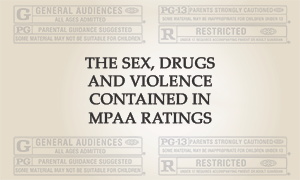
In a month's time, the Motion Picture Association of America (MPAA) will be celebrating the 50th anniversary of their rating system, and so it seemed an opportune moment to take a dive into the data behind MPAA ratings.
From 1968, a new voluntary code was established for movie certification in America, managed by the MPAA, along with the National Association of Theater Owners (NATO) and the International Film Importers & Distributors of America (IFIDA).
The system has been tweaked a few times since its creation and was last updated in 1996 when the ratings were set as:
G: General Audiences – all ages admitted
PG: Parental Guidance Suggested – some material may not be suitable for children
PG-13: Parents Strongly Cautioned – some material may be inappropriate for children under 13
R: Restricted – under 17 requires accompanying parent or adult guardian
NC-17: No one 17 and under admitted
In order to study these ratings, I gathered data on 6,288 films which received an MPAA certificate and were released between 2000 and 2017.
MPAA ratings
Let's start with a quick overview of how common each of the ratings are.
Over the past twenty films, 52% of movies with MPAA ratings have received an R-rating. Around a third have been PG-13 rated, 14% PG-rated, 2% G rated and 0.3% have been NC-17.
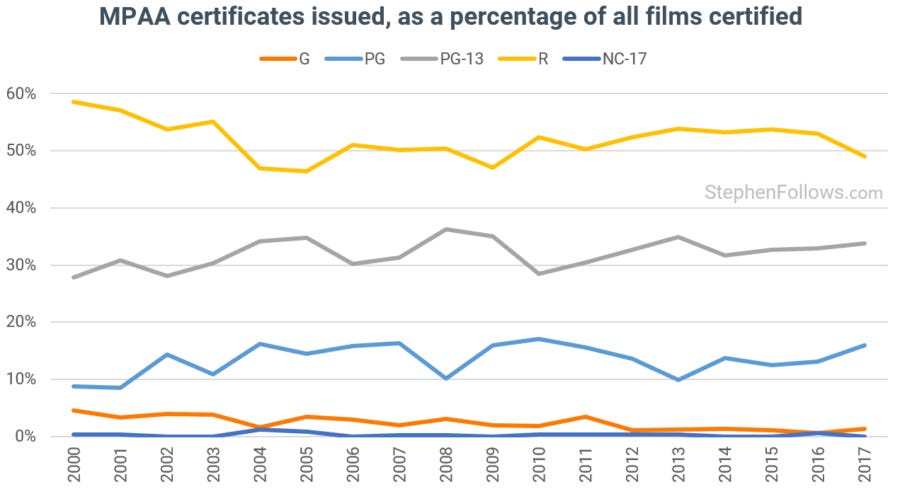
Although it may seem that R-rated movies have a dominant market position, if we turn our attention to box office figures, a different picture emerges.
For most of the past few decades, half of the domestic box office (i.e. cinemas in the US and Canada) has been collected by movies rated as PG-13 by the MPAA.
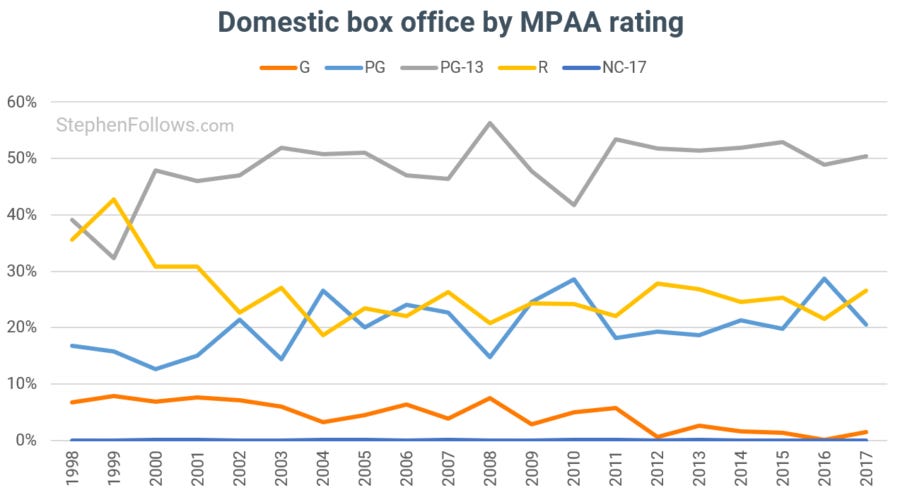
When I simplified the data and put the two datasets next to each other, the differences between supply and demand are clear.
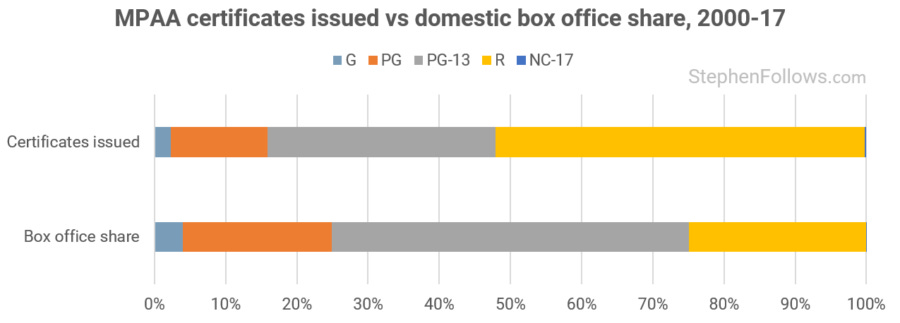
Note: the chart above is looking at the films that received a rating. This doesn't include films that chose not to be rated by the MPAA. 'Unrated' films accounted for just 0.8% of the total domestic box office over this period.
Warning: This section includes graphical illustrations of violent scenes
If we dig a little deeper, we can start to understand why each rating was awarded. In 1990, the MPAA started adding a few words of explanation as to why they awarded a film an R-rating, and from 2000 they expanded this to also include films rated PG, PG-13 and NC-17.
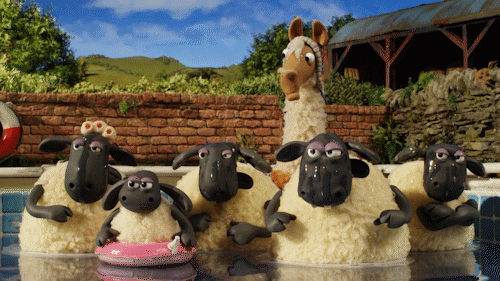
Some are very simple, including:
"For themes" - The Remains of the Day
"For language" - Happy-Go Lucky
"For rude humor" - Shaun the Sheep
While others are little horror stories in themselves:
"For bizarre and disturbing content, including drug use, sexuality, and gruesome situations - all involving children, and for some language" - Tideland
"For disturbing and perverse behavior throughout, including violence, gruesome images, strong sexual content, nudity, drug use and language" - Pathology
"For crude and sexual content throughout, nudity, drugs, drinking, pervasive language, reckless behavior and mayhem - all involving teens" - Project X
I gathered all the MPAA explanations for movies released in US cinemas between 2000 and 2017 and took a look at what they can tell us.
We'll start by looking at violence and terror.
The blue charts below show what percentage of movies of each genre mentioned elements of violence or terror in their MPAA explanation. As you can see, nine out of ten horror movies and action movies earned their rating in part due to violent scenes or elements.
Romantic comedies are the least violent and terrifying of all major genres (unless you're currently single, in which case they might seem very scary).
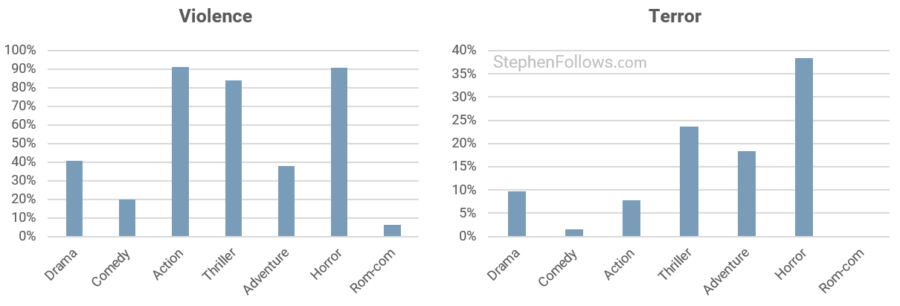
We can dig one level deeper, and look at how the MPAA refers to the violence. In some cases, they add phrases like "brief", "some", "strong" or "pervasive" ahead of the phrase "violence" or "violent".
This allows us to see that although thrillers initially appeared to have similar levels of violence to action and horror movies, in fact they tend to have milder or less frequent violent elements.
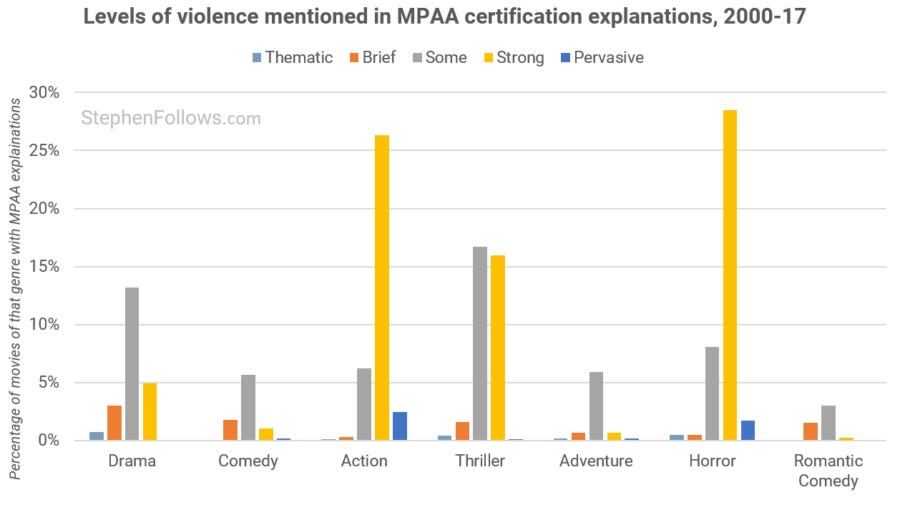
Sex sells (movie tickets)
Next up, sexual content. 72% of romantic comedies have some kind of sexual content, although horror films have a greater chance of containing nudity.
Also, note the difference between action and adventure films. I'm often asked how these two genres differ and my short answer is the age of the intended audience. Adventure films hope to attract the whole family, whereas action films tend to have more extreme content and older audiences. This was visible in the violence measured in the previous section and also here in the level of sexual content.
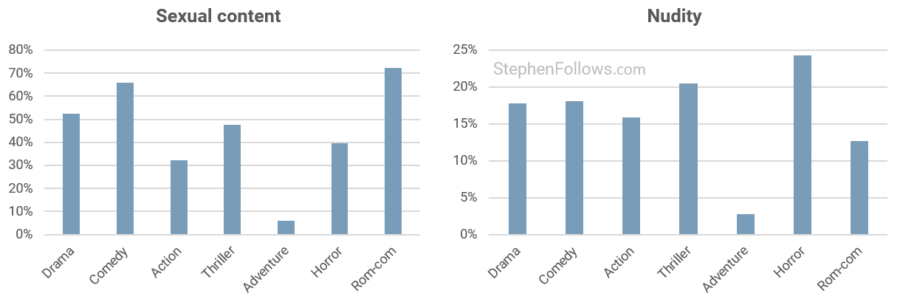
Thrillers may have fewer references to sexual content than romantic comedies, but when they are present, they tend to be more extreme.
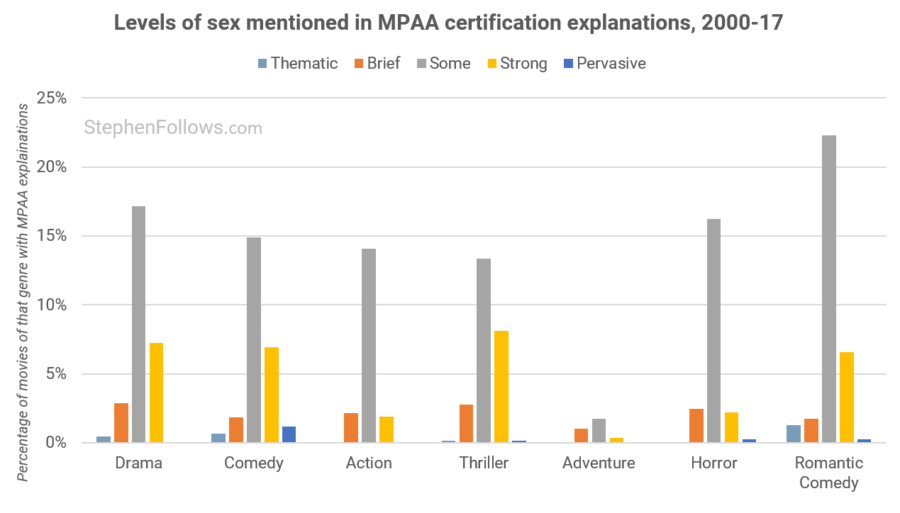
Crude, rude and lewd
We've done 'sticks and stones' and 'the birds and the bees' - let's move on to words. Bad language is frequently cited in MPAA explanations, appearing in 76% of all issued certificates.
The genre with the most frequent bad language warning is comedy, closely followed by thrillers and romantic comedies. The least likely to contain bad language are adventure films, although conversely, they are the most likely to contain "crude" or "rude" references. I presume that this is because they avoid actually saying no-no words but make clear inferences as to what they would like to say.
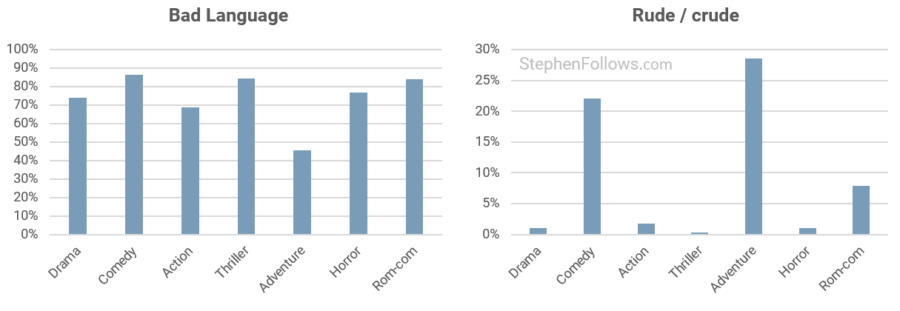
The MPAA does not often provide the same level of detail on these topics as we saw with sex or violence so we are left guessing how strong or pervasive the references are.
Vice advice
Now that the violence, sex and shouting is over, let's turn to drugs and smoking so we can end on a high.
Drug warnings are most likely to appear in comedies, and again adventure films are relatively free of vices. Smoking is a different story, with dramas and adventure films being the smokiest, although this still only refers to a very small number of films.
Across all films, drug warnings are issued by the MPAA ten times as frequently as those for smoking.

And when drugs are present in comedies, they're more often described as "some" - ie. some drug references, rather than brief references.
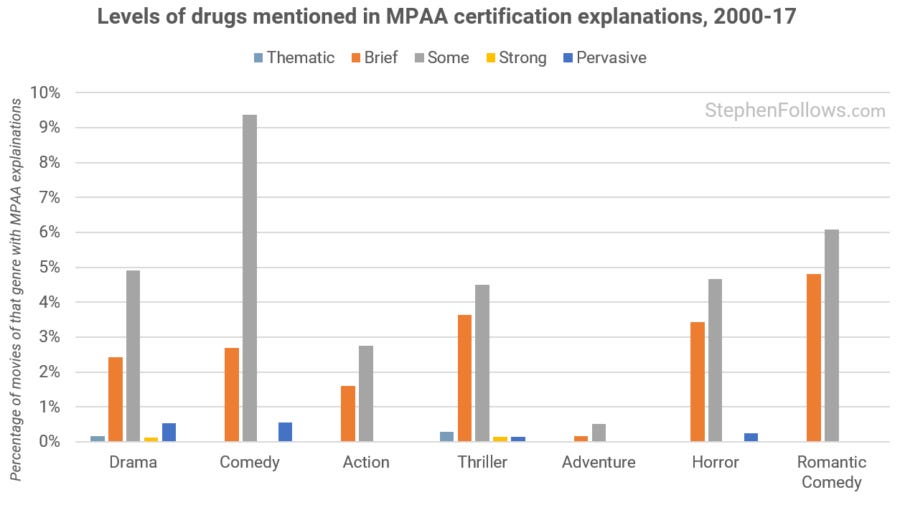
Notes
The data for today's research came from the MPAA and Opus data. I have excluded NC-17 data for some of the charts as there are so few such films as to make the results meaningless.
The box office figures for today's charts related to the "Domestic" box office, which means cinemas in America and Canada. We have no way of focusing the data to look at just American cinemas. This would be desirable as Canada has its own rating system (well, systems, as different territories have their own rules).
To create the breakdown of MPAA explanations I combined similar explanations into wider categories:
Terror includes mentions of "frightening", "peril","disturbing" and of course "terror".
Sex includes mentions of "sex", "sexuality" and "sexual".
Bad language includes "innuendo", "bad language", "suggestive language" and the rather vague "references ".
Epilogue
The MPAA system only covers movies released in America. In the UK, we have the British Board of Film Classification (BBFC) and you can read more about them and their ratings in one of my oldest articles, entitled Raters Gonna Rate – UK film censorship.

Since I wrote that article there have been new controversies of BBFC guidance. My favourite is their decision that the film Paddington should come with the warning that it contains "dangerous behaviour, mild threat, mild sexual references and infrequent mild bad language".
Paddington's creator Michael Bond was quoted as saying "I might not sleep well tonight. I can’t imagine what the sex references are. It doesn’t enter into it with the books, certainly".
It turned out that the BBFC were alluding to a scene in which Paddington distracts a museum guard by pretending to be a woman (or at the very least, a lady bear) by wearing a dress.
In the end, they gave in to pressure and updated their guidelines to remove the suggestion that Paddington contained "mild sexual references" and downgraded it to "innuendo".
Throughout all this, no-one seems to have noticed that Paddington met the Brown family at a train station butt naked, save for a big red hat.


